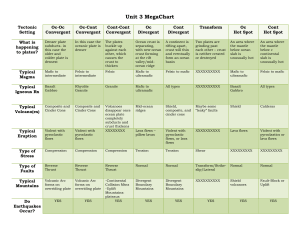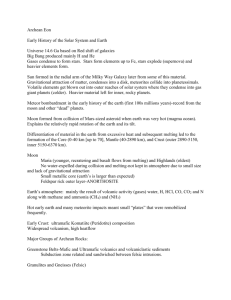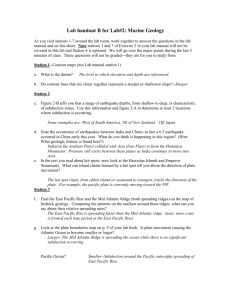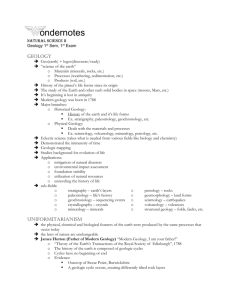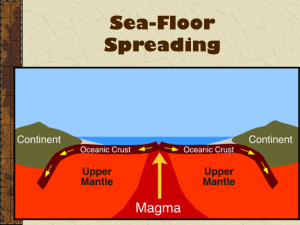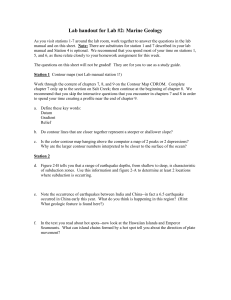Word format
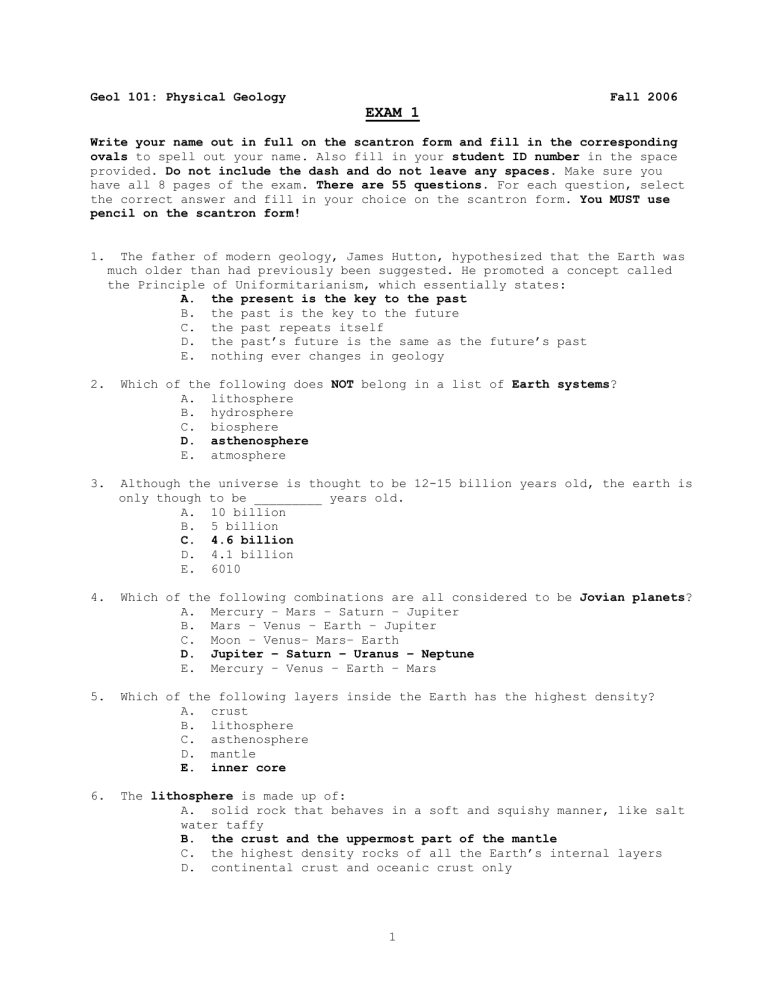
Geol 101: Physical Geology Fall 2006
EXAM 1
Write your name out in full on the scantron form and fill in the corresponding ovals to spell out your name. Also fill in your student ID number in the space provided. Do not include the dash and do not leave any spaces . Make sure you have all 8 pages of the exam. There are 55 questions. For each question, select the correct answer and fill in your choice on the scantron form. You MUST use pencil on the scantron form!
1. The father of modern geology, James Hutton, hypothesized that the Earth was much older than had previously been suggested. He promoted a concept called the Principle of Uniformitarianism, which essentially states:
A. the present is the key to the past
B. the past is the key to the future
C. the past repeats itself
D. the past’s future is the same as the future’s past
E. nothing ever changes in geology
2. Which of the following does NOT belong in a list of Earth systems ?
A. lithosphere
B. hydrosphere
C. biosphere
D. asthenosphere
E. atmosphere
3. Although the universe is thought to be 12-15 billion years old, the earth is only though to be _________ years old.
A. 10 billion
B. 5 billion
C. 4.6 billion
D. 4.1 billion
E. 6010
4. Which of the following combinations are all considered to be Jovian planets ?
A. Mercury – Mars – Saturn – Jupiter
B. Mars – Venus – Earth – Jupiter
C. Moon – Venus– Mars– Earth
D. Jupiter – Saturn – Uranus – Neptune
E. Mercury – Venus – Earth – Mars
5. Which of the following layers inside the Earth has the highest density?
A. crust
B. lithosphere
C. asthenosphere
D. mantle
E. inner core
6. The lithosphere is made up of:
A. solid rock that behaves in a soft and squishy manner, like salt water taffy
B. the crust and the uppermost part of the mantle
C. the highest density rocks of all the Earth’s internal layers
D. continental crust and oceanic crust only
1
E. magma
7.
The theory of plate tectonics had its origin in the concept of ___________ introduced in 1910 by Alfred Wegener.
A. seafloor spreading
B. subduction
C. continental drift
D. paleomagnetic reversals
E. jigsaw geology
8.
Which of the following is NOT one of the lines of evidence initially used to develop the theory of plate tectonics?
A. the shapes of the continents seem to fit so well together
B. there are similar fossils of plants and animals on different continents
C. paleomagnetic poles do not match up unless the continents used to be together
D. the geology matches up from one continent to another
E. there is clear evidence that the continents plowed their way through ancient oceanic crust
9. If the coastlines of North America and Eurasia are matched up, the (1)
___________ mountains in North America match up with the (2) _________ in
Eurasia, suggesting that they used to be one continuous mountain range.
A. (1) Appalachians
B. (1) Appalachians
(2) Caledonides
(2) Alps
C. (1) Rockies
D. (1) Rockies
E. (1) Cascades
(2) Alps
(2) Caledonides
(2) Appalachians
10. Which of the following continents is NOT considered to have been part of
Gondwana before it broke apart?
A. Africa
B. North America
C. South America
D. Australia
E. Antarctica
11. One line of evidence that Africa and South America used to be one continent is that they both show evidence of a type of plant called:
A. Cynognathus
B. Glossopteris
C. Lystrosaurus
D. Mesosaurus
E. Cycad
12. Which of the following statements about paleomagnetism at spreading ridges is FALSE ?
A. there is a clear pattern of paleomagnetic properties in seafloor rocks that formed at spreading centers
B. rocks formed at spreading ridges preserve paleomagnetic signals that repeatedly reverse through time
C. the paleomagnetic pattern on one side of a ridge is very different to that on the other side of the ridge
2
D. lavas erupting at mid-ocean ridges today would preserve a positive polarity in the magnetic signal
E. the paleomagnetic stripes in the ocean floor rocks run parallel to the spreading ridge
13. If you were to collect samples at the following locations along the sea floor of the North Atlantic ocean, which sample of rock would be the oldest?
A. along the spreading ridge
B. where the spreading ridge comes ashore in Iceland
C. just east of the spreading ridge
D. just west of the spreading ridge
E. just off the coast of North America
14. The fastest plate motion velocity that has been measured anywhere on Earth is 18 cm/yr, which occurs at the:
A. San Andreas fault
B. mid-Atlantic ridge
C. East Pacific Rise spreading ridge
D. Juan de Fuca spreading ridge
E. Sumatra subduction zone
15. Tectonic plates are not very thick compared to the radius of the Earth because they are only made up of rocks that are part of the:
A. ocean crust
B. continental crust
C. lithosphere
D. asthenosphere
E. mantle
16. Which of the following features would be expected to be found in a divergent tectonic setting?
A. rift valley
B. subduction zone
C. overriding plate
D. back-arc basin
E. volcanic arc
17. Which of the following statements about convergent plate boundaries is
TRUE ?
A. when two plates collide, at least one of the plates will always subduct
B. the collision of oceanic crust against continental crust will result in subduction of the continent
C. there are only two types of convergent boundaries: ocean-ocean and ocean-continent
D. if two ocean plates collide, melting along the subduction zone creates an island arc of volcanoes
E. it takes two continents colliding in order to form a volcanic arc mountain range
18. An example of a volcanic arc along an ocean-continent plate boundary:
A. Himalayas
B. Cascades
C. Aleutian Islands
D. Japan
3
E. Phillipines
19. The top of Mt. Everest exhibits (1) __________ which indicates that (2)
___________.
A. (1) a suture zone continent plate boundary
B. (1) a crater
(2) it must be an ocean-
C. (1) constant elevation and Asia is now complete
D. (1) glacial features pole as part of Gondwana
(2) it must be a volcano
(2) the collision between India
(2) it used to be near the south
E. (1) sea shell fossils (2) it is made of old ocean floor that got uplifted during collision
20. The San Andreas fault is an example of the following type of tectonic plate boundary:
A. divergent
B. convergent: continent-continent
C. convergent: ocean-continent
D. convergent: ocean-ocean
E. transform
21. The Hawaiian Islands are an example of volcanoes that did not form along a tectonic plate boundary. Instead, they formed in the middle of the Pacific plate directly above a:
A. convection cell
B. mantle plume
C. subduction zone
D. mid-ocean ridge
E. lava lamp
22. In the Celsius temperature scale, water freezes at (1) ____°C and boils at
(2)____°C.
A. (1) 100 (2) 0
B. (1) 0 (2) 100
C. (1) 1.8 (2) 32
D. (1) 32 (2) 212
E. the Celsius scale is not applicable to water
23. The smallest fundamental substance into which you can break down any compound using either physical or chemical means (e.g. crushing or dissolving) is:
A. a proton
B. a mineral
C. a nucleus
D. an element
E. an electron
24. The positively charged particle in an atom is a/an (1) ______; the neutral
(zero charge) particle is a/an (2) ______.
A. (1) proton (2) electron
B. (1) neutron (2) proton
C. (1) electron (2) neutron
4
D. (1) proton (2) neutron
E. (1) electron (2) moron
25. An atom that loses electrons forms a/an (1) _______ with a (2) _______ charge.
A. (1) cation (2) positive
B. (1) anion (2) positive
C. (1) isotope (2) positive
D. (1) cation (2) negative
E. (1) anion (2) negative
26. The type of chemical bonding that forms the strongest bonds (e.g. in diamond) is:
A. ionic
B. van der Waals
C. metallic
D. hydrogen
E. covalent
27. If “X” represents a cation with a charge of +1, and “Y” represents an anion with charge of –2, the correct way to write out the formula of the chemical compound produced by the ionic bonding of “X” and “Y” is:
A. YX
B. XY
C. Y
2
X
D. X
2
Y
E. impossible to determine without more information
28. Which of the following is NOT an example of a mineral that forms in covalently bonded sheets held together by weak van der Waal’s electrostatic bonds?
A. salt
B. clay
C. graphite
D. muscovite mica
E. biotite mica
29. Which of the following statements about minerals is TRUE ?
A. whenever elements come together in a specific ratio, a mineral is formed
B. water and ice are both minerals
C. gold is both an element and a mineral
D. all minerals must have more than one element in their chemical formula
E. glass is a mineral
30. If all minerals must be inorganically formed crystalline solids, which of the following substances cannot possibly be a mineral?
A. salt
B. ice
C. diamond
D. quartz
E. chalk
5
31. Quartz is generally defined as being “pure silica” yet it can form with a variety of colors. This is possible because:
A. silica naturally forms with a variety of colors
B. quartz always changes color depending on the type of light hitting it
C. atomic substitution causes some Si atoms to get replaced by different impurity atoms
D. there is no such thing as pure silica
E. the charge of the silica anion can vary, which causes different colors
32. Which of the following solids would be considered amorphous ?
A. diamond
B. glass
C. quartz
D. salt
E. ice
33. The two most abundant elements, comprising about 84% of all the atoms in the Earth’s crust, are:
A. silicon and aluminum
B. chlorine and sodium
C. hydrogen and helium
D. iron and oxygen
E. oxygen and silicon
34. The hardest known mineral is:
A. quartz
B. calcite
C. gypsum
D. talc
E. diamond
35. The mineral that dissolves and effervesces when dilute hydrochloric acid is dripped on it is:
A. talc
B. calcite
C. halite
D. dolomite
E. magnetite
36. The most abundant mineral family is the (1) ________ and the second-most abundant is the (2) _______:
A. (1) silicates
B. (1) oxides
C. (1) carbonates
D. (1) nonsilicates
E. (1) silicates
(2) oxides
(2) silicates
(2) oxides
(2) silicates
(2) carbonates
37. The silica anion contains (1) _______ arranged into a shape called a (2)
_________.
A. (1) one silicon and one oxygen (2) silicate
B. (1) one silicon and four oxygens (2) tetrahedron
C. (1) four silicons and one oxygen (2) pyramid
6
D. (1) four silicons and four oxygens (2) tetrahedron
E. (1) one silicon and four oxygens (2) pyramid
38. If a silicate mineral is referred to as being ferromagnesian , it MUST contain the following:
A. iron and sodium
B. magnesium and calcium
C. iron and magnesium
D. calcium and aluminum
E. magnesium and sodium
39. Two polymorphs or carbon are:
A. graphite and lead
B. graphite and pyrite
C. diamond and quartz
D. diamond and graphite
E. limestone and chalk
40. On average, the geothermal gradient inside the Earth’s crust is about:
A. 1000°C per kilometer
B. 100°C per kilometer
C. 50°C per kilometer
D. 25°C per kilometer
E. 10°C per kilometer
41. The inside of the earth is not completely molten (i.e. liquid) because:
A. it never gets hot enough to melt rocks deep in the earth
B. the melting temperature of rocks increases as pressure increases
C. its chemistry always causes it to be a solid with the consistency of salt water taffy
D. the earth would collapse in on itself if it had a liquid interior
E. none of the above because the inside of the earth is completely molten
42. As a rock starts to melt, the minerals with the lowest melting temperature will start to melt first, forming magma. This melted portion can get squeezed away from the still solid part of the rock through a process called:
A. partial melting
B. fractionation
C. differentiation
D. volcanic eruption
E. crystallization
43. The different types of magma, listed in order from lowest to highest silica content , are:
A. felsic, intermediate, mafic, ultramafic
B. felsic, mafic, intermediate, ultramafic
C. mafic, ultramafic, intermediate, felsic
D. ultramafic, mafic, felsic, intermediate
E. ultramafic, mafic, intermediate, felsic
7
44. Which of the following types of lava has the lowest viscosity and therefore flows the fastest and furthest?
A. felsic
B. intermediate
C. mafic
D. ultrafelsic
E. intermafic
45. The most common type of igneous rock in the solar system forms from mafic lava and is called:
A. basalt
B. granite
C. peridotite
D. limestone
E. andesite
46. What is meant when referring to the texture of an igneous rock?
A. the types of minerals present
B. the color of the rock
C. the size, shape and arrangement of mineral grains
D. whether the crystals are big or small
E. whether the rock is volcanic or plutonic
47. When lava erupts and cools, it may cool slowly enough for small crystals to grow from the lava. The resultant type of igneous rock texture is called:
A. aphanitic
B. phaneritic
C. porphyritic
D. pyroclastic
E. pegmatitic
48. Which of the following minerals is NOT a common component of igneous rocks?
A. quartz
B. feldspar
C. olivine
D. pyroxene
E. calcite
49. In Bowen’s Reaction Series , the very first mineral to crystallize in the discontinuous branch is:
A. quartz
B. feldspar
C. olivine
D. pyroxene
E. calcite
50. Igneous rocks that have similar minerals but with different crystal sizes have different names. Basalt is fine-grained because it forms from lava.
The coarse-grained plutonic equivalent that forms from magma is called:
A. andesite
B. gabbro
C. rhyolite
D. granite
8
E. diorite
BONUS QUESTIONS
51. The supercontinent that broke apart to form Gondwana and Laurasia was called:
A. Wegener
B. Pangea
C. Tethys
D. Panthalassa
E. Kattenhornia
52. The age of the oldest oceanic crust in any of the world’s oceans is:
A. 4600 million years
B. 1200 million years
C. 500 million years
D. 180 million years
E. 70 million years
53. The type of feldspar that contains either Ca or Na is called:
A. K-feldspar
B. plagioclase
C. calcite
D. olivine
E. granite
54. In a rock like granite, the mineral with the lowest melting temperature that melts first during partial melting is:
A. mica
B. quartz
C. feldspar
D. plagioclase
E. amphibole
55. I have made sure that my name and student ID number are correctly filled in on the scantron sheet and I will remember to hand in the scantron sheet and take the test question sheet with me when I leave. I will check my grade on the WebCT website.
A. yes
B.
no
C.
Snicker’s bar
9
